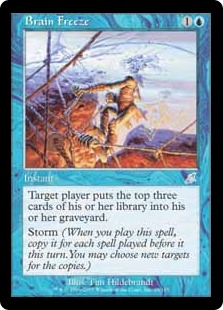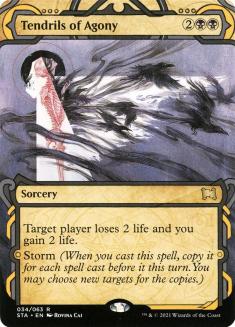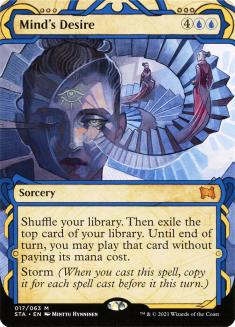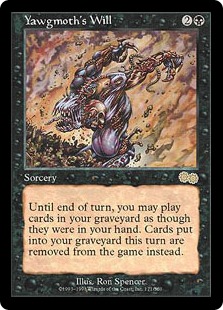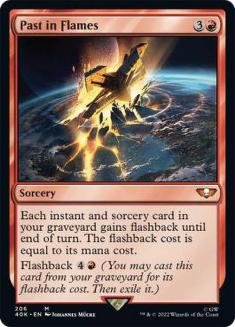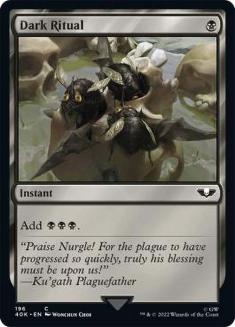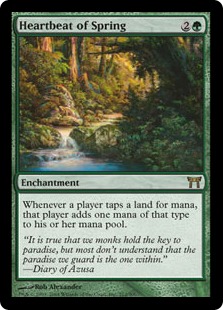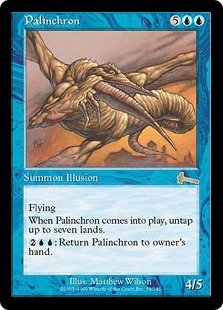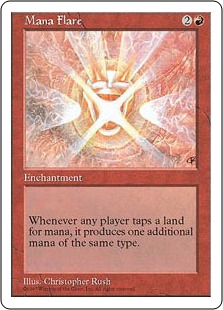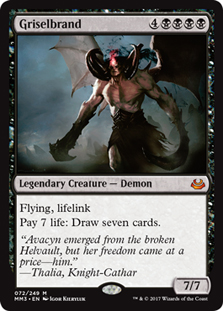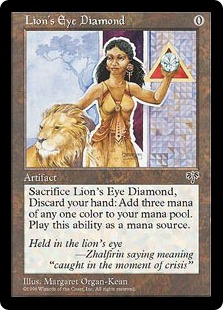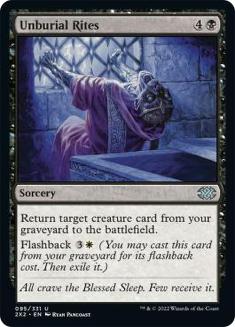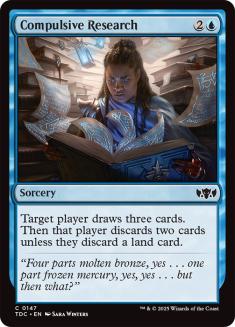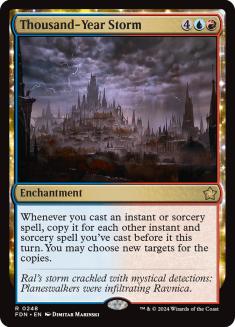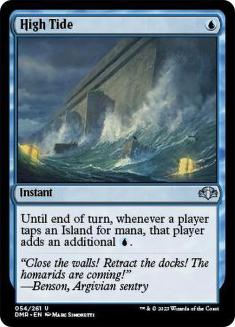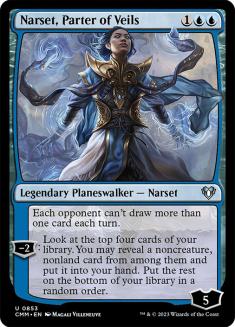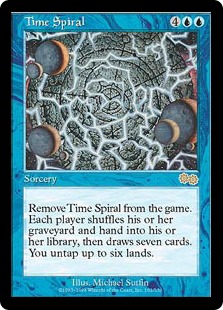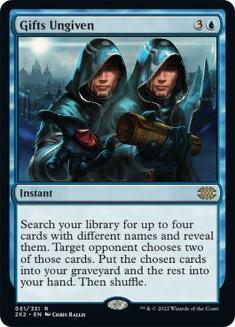Vintage Cube is such a delight. It combines all of the best parts about Magic: drafting, power, creativity, nostalgia, and more! It’s a wonderful celebration of Magic. There are numerous strategies, but only one that really separates this Cube from others: Storm.
Storm may not be the best archetype in the Cube, but the novelty of drafting a Storm deck makes it a strategy near and dear to my heart. However, the archetype does get a bad rap. Many players believe it is not only inconsistent in game, but also inconsistent to draft; What if there isn’t an opportunity to draft a card with Storm?
It actually doesn’t matter. While the classic versions of Storm in the Magic Online (MTGO) Vintage Cube win with cards like Brain Freeze and Tendrils of Agony, that’s not actually what the archetype is about. Storm is about one big turn out of nowhere. Sometimes the win condition is Pestermite and Kiki-Jiki, Mirror Breaker; sometimes it’s generating an enormous amount of mana and casting a huge Walking Ballista or even winning with Lavaclaw Reaches. There are so many ways to architect a deck of this nature that it’s not actually too difficult to navigate a draft with the intention of drafting Storm. As I’ve said, it’s not the best deck, but it’s a novelty we only get once a year, so I always force it!
Versions of Storm
The first key to drafting Storm is recognizing which version of it is available. Any of these versions can overlap depending on the pool, but I believe there are five genres of Storm decks to look out for
1. Ritual Storm
When most people think of the Storm archetype in the Vintage Cube, this is the version they think of: where the game is all set-up, until there’s a tutor for Yawgmoth’s Will alongside a Lion’s Eye Diamond and the rest is history.
This is the best version of Storm when it comes together, but it also has no backup plan. This version of Storm only works with a good storm card, good Rituals, and good recursion. I believe this is why many people think Storm has a high fail-rate. But many of the other archetypes can piece together a win through backup plans should the deck not get there in the end, so be prepared to pivot out of this archetype if possible.
2. Mana Doubler Storm
In my opinion, this is the worst version of Storm. When the deck just doesn’t get there using the backup of Palinchron and some mana doubling effects, infinite mana wins with a lot of different cards (e.g. Walking Ballista, Banefire).
The reason why I don’t like it is two-fold. First, it requires a sixth land on the battlefield and hence cannot go off in the earlier turns (note: this means cards like Kodama’s Reach and Sakura-Tribe Elder are important to the archetype). Second, it’s easier to disrupt, as it often relies on permanents.
The best Mana Doubler Storm variants aren’t reliant on infinite mana alongside Palinchron. It’s what happens when Ritual Storm doesn’t get Yawgmoth’s Will and instead tries to win via enough card draw and enough mana to cast something big. These versions generate enough mana to win by hard-casting Emrakul, the Aeons Torn and also have Show and Tell or Sneak Attack for early wins with the right draw.
3. Reanimator Storm
Reanimator Storm is the most explosive version of Storm because the best versions can win on Turn 1! All it takes is a Griselbrand on the battlefield and enough Rituals in the deck, and my favorite way to do it on Turn 1 is to use Lion’s Eye Diamond as a discard outlet for both Griselbrand and Unburial Rites. However, the overwhelming majority of Reanimator Storm decks don’t have access to the density of Rituals to win on Turn 1. That being said, they’re still quite good and have the most reliable backup plan, since putting a fatty on the battlefield in the first couple of turns is still a good recipe for success.
Thousand-Year Storm spawned its own archetype. An Izzet control deck can easily cast Thousand-Year Storm at the top of the curve and immediately win the next turn. It helps that cards like Show and Tell and Seething Song help get it out early. The best cards for the deck are Manamorphose and Frantic Search, as they churn through the deck while generating mana with Thousand-Year Storm. This allows kills on the same turn Thousand-Year Storm enters the battlefield.
These decks can be dedicated Storm decks, but they don’t have to be. Fiery Confluence or Lightning Bolt can quickly kill and are generally good cards. Even some card draw can target opponents, like Compulsive Research, functioning as a mill win-condition. The biggest problem with these decks is they can struggle to win without Thousand-Year Storm, so it’s important to play other win-conditions, which unfortunately dilutes the gameplan.
5. Mono-Blue Control Storm
I’ve saved the best for last! I believe that this is the best version of Storm because the backup plan of a good control deck is always solid. Furthermore, this archetype can often play the control axis well until it can go off, which means it doesn’t have to be as linearized as other versions. Cards like Cryptic Command, Mystic Confluence, and Remand are all fantastic pieces of interaction that can cycle when going off.
The addition of Narset, Parter of Veils is amazing for this archetype because of the prison mode alongside Timetwister and Time Spiral. Furthermore, Brain Freeze is extremely easy to win with thanks to recursion with Snapcaster Mage, Torrential Gearhulk, or Jace, Vryn’s Prodigy. Venser, Shaper Savant, and Remand can also help on this axis while functioning as good interactive pieces.
Card Prioritization
While each Storm variant is different, they all have a similar prioritization of cards. However, it’s important to note that specific cards break the mold, and how they break it actually depends on the version of Storm, the current pool, and how far into the draft the pack is. For example:
1. In the beginning of a draft where I’m starting down the Storm path, I will not pass Tendrils of Agony. It’s the kind of card that make players think about drafting Storm and I just don’t want to give them the opportunity. Common advice is to wheel Tendrils because fighting for Storm isn’t a good place to be. I agree with that in Pack 2 and Pack 3, but in Pack 1 I want to reduce the probability that another player goes for it. It also communicates to anybody who has seen that Tendrils that somebody else is going for it.
2. Density of effects is an important concept for Storm. The deck doesn’t just need multiple Rituals, it also needs an abundance of card draw, and often multiple ways to win. This is why Tutors are the most important type of card for Storm; they help find whichever piece is necessary for the win. But overall, it’s reasonable to take something like Compulsive Research over Timetwister in a Thousand-Year Storm deck in Pack 3 because it functions as card draw and a win-condition, and if the density of win-conditions isn’t there, it will be the correct pick.
3. As per usual in Vintage Cube: don’t pass Power. Both Power and honorary power (e.g. Mind Twist) are easy to integrate well into a Storm deck and are just too good. Channel is also an insane Ritual if the mana can support it.
4. Try not to pass Tutors either. As I’ve mentioned, density is important for Storm. Finding the payoff, the Ritual, the recursion, or the draw-seven is the difference between winning and losing. The more the better, and that’s fairly consistent regardless of version. The only deviation here should be on completely irreplaceable cards. In Reanimator Storm, Griselbrand is worth more than Demonic Tutor. However, usually Griselbrand is what puts me into Reanimator Storm, so even this scenario is quite rare.
5. Yawgmoth’s Will. This deserves its own class, and that’s important to recognize. Yawgmoth’s Will enables kills like no other card, and winning with Storm can be a lot more difficult without access to it.
6. Draw-sevens. While draw sevens don’t impact density as clearly as cards like Demonic Tutor, they still give the player access to so many cards that their importance is similar. Draw-sevens like Timetwister and Time Spiral are there to greatly reduce the probability of fizzling when attempting to go off. They enable seeing such a large portion of the deck that the probability of finding all the pieces is quite high. It’s important to note that a large density of draw-seven effects isn’t particularly important. Because of this, sometimes in Pack 3 it is more important to pick up a good piece of interaction, a Ritual, or even another win-condition.
While not every piece of card advantage can be as busted as draw-sevens, there are many that aren’t inherently as broken, but can be with the right deck. The most important one to highlight is Gifts Ungiven, as I find it incredibly underrated. In the majority of Storm decks I draft, Gifts Ungiven can create a pile that is likely to end the game. It’s a combination of card draw and tutoring, which is quite rare.
7. Cheap interaction. This may be a bit controversial, but I believe that the best Storm decks have access to good interaction, and I will take that above the more parasitic cards (Rituals and win-conditions). The reason for this is two-fold. First, it provides a backdoor, as with more solid playables, dipping into a random blue control deck is feasible. Second, when everybody is trying to do something broken, it’s extremely important to be able to interact. The majority of Storm decks aren’t going to have easy wins before Turn 4. And if it’s difficult to play against early cheating a fatty onto the battlefield, or even a taxing planeswalker like Liliana of the Veil or Ashiok, Nightmare Weaver, then that’s problematic.
Because the focus is on preventing devastating early plays, cheap interaction is crucial. In every other archetype, Mystic Confluence is better than Remand, Force of Will, and Mana Leak. However, in Storm, that’s not the case. Mystic Confluence is still a busted card, but it’s just not as important. It is correct to include in all but the most exceptional Storm decks.
8. The best win-conditions. The best Storm cards and Emrakul, the Aeons Torn, in my opinion, are the best win-conditions for this archetype. It’s pretty easy to cheat Emrakul onto the battlefield, whether with Sneak Attack, Through the Breach, Show and Tell, or even something else! Many versions of Storm can also just generate enough mana to cast Emrakul. There are other good win-conditions (e.g. best reanimation targets for Reanimator Storm, Walking Ballista for Mana Doubler Storm, and Thousand-Year Storm for the controlling Storm decks), but these three are the best in the average case, and the only ones I prioritize early in Pack 1.
It is important to note that cards like Thing in the Ice, Monastery Mentor, and Young Pyromancer can be solid depending on the texture of the deck. They mostly are very strong sideboard options, but alongside Time Walk and Time Warp can be very potent backup threats.
9. Rituals. The backbone of Storm decks is mana acceleration. I don’t take them as highly as the premium and irreplaceable effects discussed above, but access to them is what makes the archetype tick. They would be higher up on this list if there wasn’t such a huge density of them, but as is I’m never particularly worried about getting enough, especially with Baral, Chief of Compliance and Goblin Electromancer counting in this space as well.
10. Efficient card draw. Once the shell of the deck is solid (everything above this section), cantrips are next-best. Smoothing out draws and helping set up for the win is a crucial part of a consistent Storm deck.
And that’s all there is to it! Prioritize cards in this way and use the definitions of the five types of Storm decks to break from these heuristics, and drafting Storm in the MTGO Vintage Cube becomes an approachable and fascinating puzzle. So go fire up a draft!

